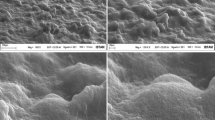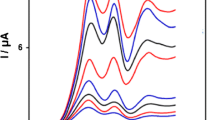Abstract
In this research, a (7,8-dihydroxy-3,3,6-trimethyl-3,4-dihydrodibenzo[b,d]furan-1(2H)-one] (DTDF) multi-walled carbon nanotube modified carbon paste electrode was constructed and used as an excellent electrocatalyst in the oxidation of levodopa (LD) in the presence of acetaminophen (AC) and tryptophan (TRP). In the first part of the work, we synthesized DTDF by electrochemically oxidizing the catechol derivative in the presence of dimedone as a nucleophile in an aqueous solution. A modified carbon paste electrode based on this electrosynthesised compound (DTDF) and carbon nanotubes (CNTs) was prepared. Cyclic voltammetry was used to investigate the redox properties of this modified electrode at various scan rates. Next, the mediated oxidation of LD at the modified electrode was described. At the optimum pH of 7.0, the oxidation of LD occurs at a potential about 330 mV less positive than that of an unmodified carbon paste electrode. Based on differential pulse voltammetry (DPV), the oxidation of LD exhibited a dynamic range between 1.0 and 1000.0 μM and a detection limit of 0.46 μM. DPV was used for simultaneous determination of LD, AC, and TRP at the modified electrode and quantitation of LD, AC, and TRP in some real samples by the standard addition method.







Similar content being viewed by others
References
Iijima S, Ichihashi T (1993) Single-shell carbon nanotubes of 1-nm diameter. Nature 363:603–605
Mazloum-Ardakani M, Sheikh-Mohseni MA (2011) Carbon Nanotubes in Electrochemical Sensors, Carbon Nanotubes - Growth and Applications, Dr. Mohammad Naraghi (Ed.), InTech, doi:10.5772/20604
Mazloum-Ardakani M, Khoshroo A (2014) Electrocatalytic properties of functionalized carbon nanotubes with titanium dioxide and benzofuran derivative/ionic liquid for simultaneous determination of isoproterenol and serotonin. Electrochim Acta 130:634–641
Goyal RN, Gupta VK, Chatterjee S (2008) Simultaneous determination of adenosine and inosine using single-wall carbon nanotubes modified pyrolytic graphite electrode. Talanta 76:662–668
Mazloum-Ardakani M, Sabaghian F, Khoshroo A et al (2014) Electrochemical determination of captopril in the presence of acetaminophen, tryptophan, folic acid, and l-cysteine at the surface of modified carbon nanotube paste electrode. Ionics 25:1–12
Luo S, Wu Y, Gou H (2013) A voltammetric sensor based on GO–MWNTs hybrid nanomaterial-modified electrode for determination of carbendazim in soil and water samples. Ionics 19:673–680
Adams R (1958) Carbon paste electrodes. Anal Chem 30:1576
Mazloum-Ardakani M, Ahmadi SH, Mahmoudabadi ZS, et al. (2014) Electrochemical and catalytic investigations of epinephrine, acetaminophen and folic acid at the surface of titanium dioxide nanoparticle-modified carbon paste electrode. Ionics 20:1757–1765
Mazloum-Ardakani M, Sheikh-Mohseni M, Mirjalili B-F (2014) Nanomolar detection limit for determination of norepinephrine in the presence of acetaminophen and tryptophan using carbon nanotube-based electrochemical sensor. Ionics 20:431–437
Ensafi AA, Izadi M, Karimi-Maleh H (2013) Sensitive voltammetric determination of diclofenac using room-temperature ionic liquid-modified carbon nanotubes paste electrode. Ionics 19:137–144
Hardy J, Gwinn-Hardy K (1998) Genetic classification of primary neurodegenerative disease. Science 282:1075–1079
Katzenschlager R, Poewe W (2014) Parkinson disease: intestinal levodopa infusion in PD—the first randomized trial. Nat Rev Neurol 10:128–129
Nagaraja P, Murthy KC, Rangappa KS, Gowda NM (1998) Spectrophotometric methods for the determination of certain catecholamine derivatives in pharmaceutical preparations. Talanta 46:39–44
Fatibello-Filho O, da Cruz Vieira I (1997) Flow injection spectrophotometric determination of L-dopa and carbidopa in pharmaceutical formulations using a crude extract of sweet potato root [Ipomoea batatas (L.) Lam.] as enzymatic source. Analyst (Cambridge, U K) 122:345–350
Doležalová M, Tkaczykova M (1999) Direct high-performance liquid chromatographic determination of the enantiomeric purity of levodopa and methyldopa: comparison with pharmacopoeial polarimetric methods. J Pharm Biomed Anal 19:555–567
Mazloum-Ardakani M, Khoshroo A (2013) Nano composite system based on coumarin derivative–titanium dioxide nanoparticles and ionic liquid: Determination of levodopa and carbidopa in human serum and pharmaceutical formulations. Anal Chim Acta 798:25–32
Mazloum-Ardakani M, Taleat Z, Khoshroo A et al (2012) Electrocatalytic oxidation and voltammetric determination of levodopa in the presence of carbidopa at the surface of a nanostructure based electrochemical sensor. Biosens Bioelectron 35:75–81
Mazloum-Ardakani M, Sheikh-Mohseni MA, Abdollahi-Alibeik M, Benvidi A (2012) Application of nanosized MCM-41 to fabrication of a nanostructured electrochemical sensor for the simultaneous determination of levodopa and carbidopa. Analyst (Cambridge, U K) 137:1950–1955
Goyal RN, Gupta VK, Chatterjee S (2008) Electrochemical oxidation of 2′,3′-dideoxyadenosine at pyrolytic graphite electrode. Electrochim Acta 53:5354–5360
Goyal RN, Gupta VK, Bachheti N, Sharma RA (2008) Electrochemical sensor for the determination of dopamine in presence of high concentration of ascorbic acid using a Fullerene‐C60 coated gold electrode. Electroanalysis 20:757–764
Gupta VK, Mangla R, Khurana U, Kumar P (1999) Determination of uranyl ions using poly(vinyl chloride) based 4-tert-butylcalix [6]arene membrane sensor. Electroanalysis 11:573–576
Gupta VK, Prasad R, Kumar P, Mangla R (2000) New nickel (II) selective potentiometric sensor based on 5, 7, 12, 14-tetramethyldibenzotetraazaannulene in a poly (vinyl chloride) matrix. Anal Chim Acta 420:19–27
Gupta VK, Prasad R, Kumar A (2003) Preparation of ethambutol–copper (II) complex and fabrication of PVC based membrane potentiometric sensor for copper. Talanta 60:149–160
Gupta VK, Nayak A, Agarwal S, Singhal B (2011) Recent advances on potentiometric membrane sensors for pharmaceutical analysis. Comb Chem High Throughput Screen 14:284–302
Jain AK, Gupta VK, Singh LP, Raisoni JR (2006) A comparative study of Pb2+ selective sensors based on derivatized tetrapyrazole and calix [4] arene receptors. Electrochim Acta 51:2547–2553, 18
Gupta VK, Jain S, Khurana U (1997) A PVC-based pentathia-15-crown-5 membrane potentiometric sensor for mercury(II). Electroanalysis 9:478–480
Gupta VK, Sethi B, Sharma RA et al (2013) Mercury selective potentiometric sensor based on low rim functionalized thiacalix [4]-arene as a cationic receptor. J Mol Liq 177:114–118
Gupta VK, Chandra S, Mangla R (2002) Dicyclohexano-18-crown-6 as active material in PVC matrix membrane for the fabrication of cadmium selective potentiometric sensor. Electrochim Acta 47:1579–1586
Gupta VK, Jain S, Chandra S (2003) Chemical sensor for lanthanum(III) determination using aza-crown as ionophore in poly(vinyl chloride) matrix. Anal Chim Acta 486:199–207
Gupta VK, Chandra S, Lang H (2005) A highly selective mercury electrode based on a diamine donor ligand. Talanta 66:575–580
Gupta VK, Jain AK, Maheshwari G et al (2006) Copper (II)-selective potentiometric sensors based on porphyrins in PVC matrix. Sensor Actuator B Chem 117:99–106
Gupta VK, Singh AK, Mehtab S, Gupta B (2006) A cobalt(II)-selective PVC membrane based on a Schiff base complex of N, N′-bis(salicylidene)-3,4-diaminotoluene. Anal Chim Acta 566:5–10
Prasad R, Gupta VK, Kumar A (2004) Metallo-tetraazaporphyrin based anion sensors: regulation of sensor characteristics through central metal ion coordination. Anal Chim Acta 508:61–70
Gupta VK, Jain AK, Kumar P (2006) PVC-based membranes of N, N′-dibenzyl-1, 4, 10, 13-tetraoxa-7, 16-diazacyclooctadecane as Pb (II)-selective sensor. Sensor Actuator B Chem 120:259–265
Gupta VK, Jain AK, Kumar P et al (2006) Chromium(III)-selective sensor based on tri-o-thymotide in PVC matrix. Sensor Actuator B Chem 113:182–186
Gupta VK, Singh AK, Al Khayat M, Gupta B (2007) Neutral carriers based polymeric membrane electrodes for selective determination of mercury (II). Anal Chim Acta 590:81–90
Gupta VK, Singh LP, Singh R et al (2012) A novel copper (II) selective sensor based on dimethyl 4, 4′(o-phenylene) bis (3-thioallophanate) in PVC matrix. J Mol Liq 174:11–16
Srivastava SK, Gupta VK, Jain S (1996) PVC-based 2, 2, 2-cryptand sensor for zinc ions. Anal Chem 68:1272–1275
Jain A, Gupta V, Singh L, others (1997) Macrocycle based membrane sensors for the determination of cobalt(II) ions. Analyst 122:583–586
Gupta VK, Ganjali MR, Norouzi P et al (2011) Electrochemical analysis of some toxic metals by ion–selective electrodes. Crit Rev Anal Chem 41:282–313
Goyal RN, Gupta VK, Bachheti N (2007) Fullerene-C60-modified electrode as a sensitive voltammetric sensor for detection of nandrolone—an anabolic steroid used in doping. Anal Chim Acta 597:82–89
Ford MD (2001) Clinical toxicology. Saunders, Philadelphia, PA
Smilkstein MJ, Knapp GL, Kulig KW, Rumack BH (1988) Efficacy of oral N-acetylcysteine in the treatment of acetaminophen overdose. N Engl J Med 319:1557–1562
Bosch ME, Sanchez AJ, Rojas FS, Ojeda CB (2006) Determination of paracetamol: historical evolution. J Pharm Biomed Anal 42:291–321
Roggo Y, Chalus P, Maurer L et al (2007) A review of near infrared spectroscopy and chemometrics in pharmaceutical technologies. J Pharm Biomed Anal 44:683–700
Mazloum-Ardakani M, Hosseinzadeh L, Khoshroo A et al (2014) Simultaneous determination of isoproterenol, acetaminophen and folic acid using a novel nanostructure-based electrochemical sensor. Electroanalysis 26:275–284
Mazloum-Ardakani M, Sheikh-Mohseni MA, Mirjalili B-F, Zamani L (2012) Simultaneous determination of captopril, acetaminophen and tryptophan at a modified electrode based on carbon nanotubes. J Electroanal Chem 686:12–18
Gupta VK, Jain R, Radhapyari K et al (2011) Voltammetric techniques for the assay of pharmaceuticals—a review. Anal Biochem 408:179–196
Wurtman RJ, Hefti F, Melamed E (1980) Precursor control of neurotransmitter synthesis. Pharmacol Rev 32:315–335
Munn DH, Zhou M, Attwood JT et al (1998) Prevention of allogeneic fetal rejection by tryptophan catabolism. Science 281:1191–1193
Grahame Smith DG (1971) Inhibitory effect of chlorpromazine on the syndrome of hyperactivity produced by l-tryptophan or 5-methoxyN, dimethyltryptamine in rats treated with a monoamine oxidase inhibitor. Br J Pharmacol 43:856–864
Fouladgar M, Karimi-Maleh H, Hosseinzadeh R (2013) Novel nanostructured electrochemical sensor for voltammetric determination of N-acetylcysteine in the presence of high concentrations of tryptophan. Ionics 19:665–672
Nematollahi D, Habibi D, Rahmati M, Rafiee M (2004) A facile electrochemical method for synthesis of new benzofuran derivatives. J Org Chem 69:2637–2640, 20
Nematollahi D, Rafiee M, Fotouhi L (2009) Mechanistic study of homogeneous reactions coupled with electrochemical oxidation of catechols. J Iran Chem Soc 6:448–476
Mazloum-Ardakani M, Khoshroo A, Nematollahi D, Mirjalili B-F (2012) Electrochemical study of catechol derivatives in the presence of β-diketones: synthesis of benzofuran derivatives. J Electrochem Soc 159:H912–H917
Bard AJ, Faulkner LR (2000) Electrochemical methods: fundamentals and applications, 2nd ed. Wiley, New York, p 237, 33, 497, 163
Laviron E (1979) General expression of the linear potential sweep voltammogram in the case of diffusionless electrochemical systems. J Electroanal Chem Interfacial Electrochem 101:19–28
Galus Z, Reynolds GF, Marcinkiewicz S (1976) Fundamentals of electrochemical analysis. Ellis Horwood, New York
Acknowledgments
The authors wish to thank the Yazd University Research Council, IUT Research Council and Excellence in Sensors for financial support of this research.
Author information
Authors and Affiliations
Corresponding author
Rights and permissions
About this article
Cite this article
Mazloum-Ardakani, M., Zokaie, M. & Khoshroo, A. Carbon nanotube electrochemical sensor based on and benzofuran derivative as a mediator for the determination of levodopa, acetaminophen, and tryptophan. Ionics 21, 1741–1749 (2015). https://doi.org/10.1007/s11581-014-1342-6
Received:
Revised:
Accepted:
Published:
Issue Date:
DOI: https://doi.org/10.1007/s11581-014-1342-6




